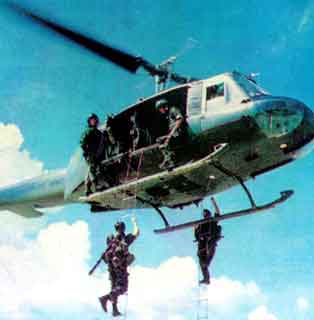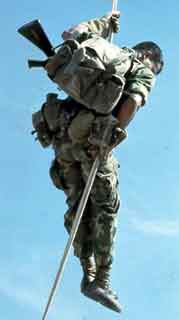Operation Lam-Son 719 in the early of February 1971 was planned to take and destroy sanctuary base 604 of
the North Vietnamese Army (NVA). This base located in Tchepone, a small town in southern of Laos.
Intelligence analysts stated that the NVA had built many large storages stocked with weapons, ammunitions,
logistic supplies and foods. Also this base was used as a resource for refreshing, troops replacement and
training for the NVA units after battled with the RVN Armed Forces. Backed by this base, the communist
forces crossed the Laos-Vietnam border to attack the Quang Tri province. In the south of base 604 closer
to the border, there was base 611, and from this base the enemy could launch attacks into the city of Hue,
Thua Thien province.
The operation also carried an important meaning in the Vietnamization program.
No American infantry soldier
landed feet in the land of Laos, all American advisors attached to the RVN units were ordered to stay in
Vietnam. Lam-Son 719 operation began at 7:00am on the 8th of February, as the leading element of the RVN
1st Cavalry with M-41 tanks and M-113 APCs crossed the border into Laos on route 9.
This route was narrow
and rough terrain slowered the advancing of the RVN forces. Meanwhile, U.S. helicopters of the 223rd and
158th Combat Aviation battalions left Khe Sanh packed with troops from the RVN Airborne, 1st Infantry
divisions and the 1st Rangers group. Khe Sanh combat base was used as the forward headquarters of the
ARVN I-Corps. The chopters transported RVN troopers to their areas of operations (AO).
 The 1st rangers group participated in the operation with two battalions, the 21st and the 39th, the 37th
was in another operation in MR-I. The forward headquarters of the group moved in Ta Bat, northwest of Khe
Sanh, close to the Laos border. The 21st battalion was heli-born into the LZ “Rangers South”, about 5km
northeast of fire support base (FSB) 30. Three days later, the 39th was brought into the LZ “Rangers
North”, 3km northeast of LZ Rangers South. The two ranger battalions assignment was the sensor to detect
the NVA movements and to delay the spear-heads of attacks of the enemy toward FSBs 30, 31.
If the
communist overran the two FSBs, they cut the retreating route 9 of the RVN forces.
The 1st rangers group participated in the operation with two battalions, the 21st and the 39th, the 37th
was in another operation in MR-I. The forward headquarters of the group moved in Ta Bat, northwest of Khe
Sanh, close to the Laos border. The 21st battalion was heli-born into the LZ “Rangers South”, about 5km
northeast of fire support base (FSB) 30. Three days later, the 39th was brought into the LZ “Rangers
North”, 3km northeast of LZ Rangers South. The two ranger battalions assignment was the sensor to detect
the NVA movements and to delay the spear-heads of attacks of the enemy toward FSBs 30, 31.
If the
communist overran the two FSBs, they cut the retreating route 9 of the RVN forces.
After landing, the rangers established defensive positions in the areas surrounding of the landing zones
(LZ) then rangers companies fanned out searching for the enemy’s trails and activities in their area of res
ponsibility (AO). Beginning the 14th, leading platoons of the 39th started exchanging gun-fires with the
enemy forces, forward artillery observer called for supports.. I n the operation, the rangers were
supported directly from a company of the 64th artillery battalion from Phu Loc. Until 3, 4:00pm all
companies engaged in fighting with the surrounding NVA units. The 64th artillery company with six 105mm
guns could not keep up with the intensity of the battle. In desperate, the forward observer broke in the
working frequency of the C/44th artillery company on FSB 30 and requested for support.
With the effects of
artillery supports, the NVA had to pull back, the rangers also fell back to defense the battalion command
post.
On the following days, the 39th rangers sent its companies out on patrol in the AO, they killed 43 enemies
and captured two 37mm AAA guns. The AAA guns indicated that the NVA had a large size of unit in the
surrounding areas of the ranger north. In the south, the paratroopers, infantry discovered storages of
foods, fuels, weapons... and dead NVA troops killed by B-52s bombing earlier.
Until the 18th, the NVA Corps 70B moved its divisions 308th, 304th, 320th, 324B together with Tanks
regiment, artillery regiment to counter-attack. On this day, they concentrated to up-root the 39th
rangers with human wave tactic. The rangers fought gallantly and with artillery supports from Phu Loc
and FSB 30, the communists attacks was repulsed, left hundreds of bodies in the battlefield, the rangers
more than 500 weapons of all kinds.
The next morning, the NVA troops returned to continue the attack.
The battle soon turned into the killing ground.
The RVN artillery from the 64th battalion and the C/44th company fired continuously supporting the rangers.
The 39th ranger battalion hang on for another day, when the enemy pulled back for realignment spear-head for the attack, the slightly wounded rangers were bandaged quickly then returning to the trenches.
The rangers probably knew their destiny, they prepared for the last fight... 20th of February, early in
the morning, the NVA mounted a new attack with more intensity. The battle lasted into afternoon and the
rangers reaction weaken... then the 64th and the C/44th artillery companies did not hear any calls for
helps from the forward observer of the 39th rangers. The communists already swamped into the rangers
positions. Aerial photos showed at least 600 NVA bodies left in the battlefield.
The survivors of the 39th
ran back to the defensive line of the 21st rangers and continued to fight side by side with brothers in
arms of the 21st until this battalion was also evacuated.
 News of the 39th ranger battalion fought until the last bullets then dispersed instead of surrendering
spread out rapidly. Lt. Col. Molinelli of the U.S. Air Cavalry wrote: “We could not re-supply for them for
three days. When ammunitions were about to run out, they got out of their positions, counter-attacked then
continued to fight with captured weapons”.
News of the 39th ranger battalion fought until the last bullets then dispersed instead of surrendering
spread out rapidly. Lt. Col. Molinelli of the U.S. Air Cavalry wrote: “We could not re-supply for them for
three days. When ammunitions were about to run out, they got out of their positions, counter-attacked then
continued to fight with captured weapons”.
After overran the 39th, the NVA forces moved south and surrounded the 21st ranger positions.
I n the night
of the 20th, flares lighted up the sky above the 21st rangers location in the area of LZ “Ranger South” .
It was the last outer shell which shielded the FSB 30 from the enemy advances from the northwest.
The NVA
began their attacks on the rangers positions since the 21st of May, the rangers fought back and held their
positions. The battle between the 21st and the survivors of the 39th with the NVA units lasted for 4 days
and nights. When the enemy pulled back after waves of attacks they pounded on the rangers positions with
122mm and 130mm shells to weaken the ranger physicals and morals.
In preserving the ranger battalion, in the morning of the 25th, the 21st rangers was ordered to evacuate
according to plan “Zulu 1”. Again the 64th and C/44th artilleries were directed to maximize fire-support
for the rangers. About 10:00am in the morning, four Cobra gun-ships circled above the rangers positions
then a squadron of helicopters landed quickly in the LZ “Rangers South” to scoop up the rangers and
brought them to FSB 30. Later another squadron arrived at FSB 30 picked up the rangers and transported
them back to Phu Loc, accomplishing the commitment of the 1st rangers group in operation Lam-Son 719.
However, one company of the 21st rangers battalion was left behind on FSB 30, they fought together with
the men in the FSB 30 until this FSB was also forced to retreat.
Dallas, Texas 07-
25th 1995
Hieu D. Vu
From the books:
- Will Fowler, The Vietnam Story, Winchmore Publishing Services, 1983
- John Pimlott, Vietnam the decisive battles, Marshall Editions Developments, Ltd. 1990
- Nguyen duc Phuong, Nhung tran danh lich su trong chien tranh Viet Nam, Dai Nam, 1993
- Truong duy Hy, Tu thu can cu hoa luc 30, Dai Nam
 Menu
Menu Menu
Menu